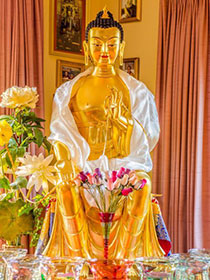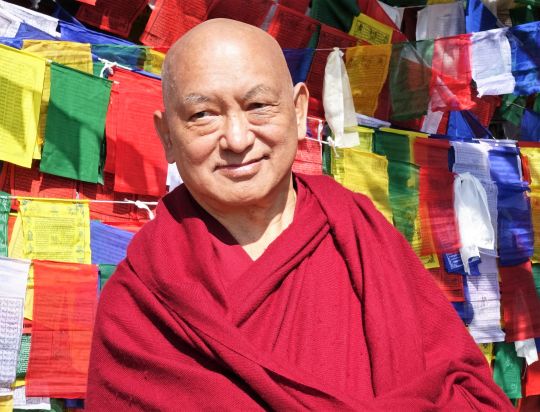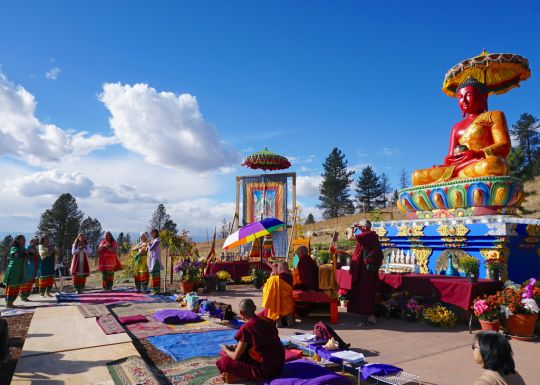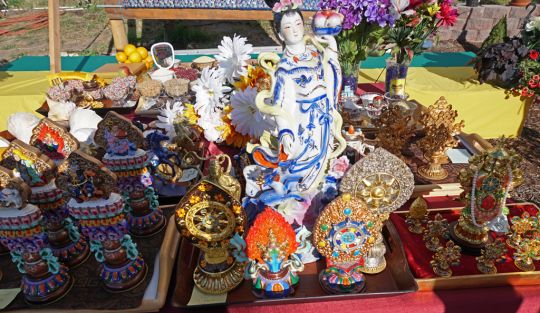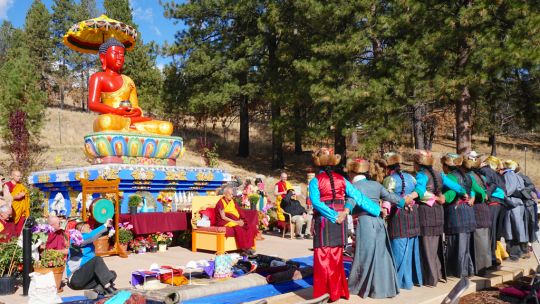- Home
- FPMT Homepage
Foundation for the Preservation of the Mahayana Tradition
The FPMT is an organization devoted to preserving and spreading Mahayana Buddhism worldwide by creating opportunities to listen, reflect, meditate, practice and actualize the unmistaken teachings of the Buddha and based on that experience spreading the Dharma to sentient beings. We provide integrated education through which people’s minds and hearts can be transformed into their highest potential for the benefit of others, inspired by an attitude of universal responsibility and service. We are committed to creating harmonious environments and helping all beings develop their full potential of infinite wisdom and compassion. Our organization is based on the Buddhist tradition of Lama Tsongkhapa of Tibet as taught to us by our founders Lama Thubten Yeshe and Lama Thubten Zopa Rinpoche.
- Willkommen
Die Stiftung zur Erhaltung der Mahayana Tradition (FPMT) ist eine Organisation, die sich weltweit für die Erhaltung und Verbreitung des Mahayana-Buddhismus einsetzt, indem sie Möglichkeiten schafft, den makellosen Lehren des Buddha zuzuhören, über sie zur reflektieren und zu meditieren und auf der Grundlage dieser Erfahrung das Dharma unter den Lebewesen zu verbreiten.
Wir bieten integrierte Schulungswege an, durch denen der Geist und das Herz der Menschen in ihr höchstes Potential verwandelt werden zum Wohl der anderen – inspiriert durch eine Haltung der universellen Verantwortung und dem Wunsch zu dienen. Wir haben uns verpflichtet, harmonische Umgebungen zu schaffen und allen Wesen zu helfen, ihr volles Potenzial unendlicher Weisheit und grenzenlosen Mitgefühls zu verwirklichen.
Unsere Organisation basiert auf der buddhistischen Tradition von Lama Tsongkhapa von Tibet, so wie sie uns von unseren Gründern Lama Thubten Yeshe und Lama Thubten Zopa Rinpoche gelehrt wird.
- Bienvenidos
La Fundación para la preservación de la tradición Mahayana (FPMT) es una organización que se dedica a preservar y difundir el budismo Mahayana en todo el mundo, creando oportunidades para escuchar, reflexionar, meditar, practicar y actualizar las enseñanzas inconfundibles de Buda y en base a esa experiencia difundir el Dharma a los seres.
Proporcionamos una educación integrada a través de la cual las mentes y los corazones de las personas se pueden transformar en su mayor potencial para el beneficio de los demás, inspirados por una actitud de responsabilidad y servicio universales. Estamos comprometidos a crear ambientes armoniosos y ayudar a todos los seres a desarrollar todo su potencial de infinita sabiduría y compasión.
Nuestra organización se basa en la tradición budista de Lama Tsongkhapa del Tíbet como nos lo enseñaron nuestros fundadores Lama Thubten Yeshe y Lama Zopa Rinpoche.
A continuación puede ver una lista de los centros y sus páginas web en su lengua preferida.
- Bienvenue
L’organisation de la FPMT a pour vocation la préservation et la diffusion du bouddhisme du mahayana dans le monde entier. Elle offre l’opportunité d’écouter, de réfléchir, de méditer, de pratiquer et de réaliser les enseignements excellents du Bouddha, pour ensuite transmettre le Dharma à tous les êtres. Nous proposons une formation intégrée grâce à laquelle le cœur et l’esprit de chacun peuvent accomplir leur potentiel le plus élevé pour le bien d’autrui, inspirés par le sens du service et une responsabilité universelle. Nous nous engageons à créer un environnement harmonieux et à aider tous les êtres à épanouir leur potentiel illimité de compassion et de sagesse. Notre organisation s’appuie sur la tradition guéloukpa de Lama Tsongkhapa du Tibet, telle qu’elle a été enseignée par nos fondateurs Lama Thoubtèn Yéshé et Lama Zopa Rinpoché.
Visitez le site de notre Editions Mahayana pour les traductions, conseils et nouvelles du Bureau international en français.
Voici une liste de centres et de leurs sites dans votre langue préférée
- Benvenuto
L’FPMT è un organizzazione il cui scopo è preservare e diffondere il Buddhismo Mahayana nel mondo, creando occasioni di ascolto, riflessione, meditazione e pratica dei perfetti insegnamenti del Buddha, al fine di attualizzare e diffondere il Dharma fra tutti gli esseri senzienti.
Offriamo un’educazione integrata, che può trasformare la mente e i cuori delle persone nel loro massimo potenziale, per il beneficio di tutti gli esseri, ispirati da un’attitudine di responsabilità universale e di servizio.
Il nostro obiettivo è quello di creare contesti armoniosi e aiutare tutti gli esseri a sviluppare in modo completo le proprie potenzialità di infinita saggezza e compassione.
La nostra organizzazione si basa sulla tradizione buddhista di Lama Tsongkhapa del Tibet, così come ci è stata insegnata dai nostri fondatori Lama Thubten Yeshe e Lama Zopa Rinpoche.
Di seguito potete trovare un elenco dei centri e dei loro siti nella lingua da voi prescelta.
- 欢迎 / 歡迎
简体中文
“护持大乘法脉基金会”( 英文简称:FPMT。全名:Foundation for the Preservation of the Mahayana Tradition) 是一个致力于护持和弘扬大乘佛法的国际佛教组织。我们提供听闻,思维,禅修,修行和实证佛陀无误教法的机会,以便让一切众生都能够享受佛法的指引和滋润。
我们全力创造和谐融洽的环境, 为人们提供解行并重的完整佛法教育,以便启发内在的环宇悲心及责任心,并开发内心所蕴藏的巨大潜能 — 无限的智慧与悲心 — 以便利益和服务一切有情。
FPMT的创办人是图腾耶喜喇嘛和喇嘛梭巴仁波切。我们所修习的是由两位上师所教导的,西藏喀巴大师的佛法传承。
繁體中文
護持大乘法脈基金會”( 英文簡稱:FPMT。全名:Found
ation for the Preservation of the Mahayana Tradition ) 是一個致力於護持和弘揚大乘佛法的國際佛教組織。我們提供聽聞, 思維,禪修,修行和實證佛陀無誤教法的機會,以便讓一切眾生都能 夠享受佛法的指引和滋潤。 我們全力創造和諧融洽的環境,
為人們提供解行並重的完整佛法教育,以便啟發內在的環宇悲心及責 任心,並開發內心所蘊藏的巨大潛能 — 無限的智慧與悲心 – – 以便利益和服務一切有情。 FPMT的創辦人是圖騰耶喜喇嘛和喇嘛梭巴仁波切。
我們所修習的是由兩位上師所教導的,西藏喀巴大師的佛法傳承。 察看道场信息:
- FPMT Homepage
- News/Media
-
- Study & Practice
-
-
- About FPMT Education Services
- Latest News
- Programs
- New to Buddhism?
- Buddhist Mind Science: Activating Your Potential
- Heart Advice for Death and Dying
- Discovering Buddhism
- Living in the Path
- Exploring Buddhism
- FPMT Basic Program
- FPMT Masters Program
- FPMT In-Depth Meditation Training
- Maitripa College
- Lotsawa Rinchen Zangpo Translator Program
- Universal Education for Compassion & Wisdom
- Online Learning Center
-
- Prayers & Practice Materials
- Overview of Prayers & Practices
- Full Catalogue of Prayers & Practice Materials
- Explore Popular Topics
- Benefiting Animals
- Chenrezig Resources
- Death & Dying Resources
- Lama Chopa (Guru Puja)
- Lama Zopa Rinpoche: Compendium of Precious Instructions
- Lama Zopa Rinpoche: Life Practice Advice
- Lama Zopa Rinpoche Practice Series
- Lamrim Resources
- Mantras
- Prayer Book Updates
- Purification Practices
- Sutras
- Thought Transformation (Lojong)
- Audio Materials
- Dharma Dates - Tibetan Calendar
- Translation Services
- Publishing Services
- Ways to Offer Support
- Prayers & Practice Materials
-
- Teachings and Advice
- Find Teachings and Advice
- Lama Zopa Rinpoche Advice Page
- Lama Zopa Rinpoche: Compendium of Precious Instructions
- Lama Zopa Rinpoche Video Teachings
- ༧སྐྱབས་རྗེ་བཟོད་པ་རིན་པོ་ཆེ་མཆོག་ནས་སྩལ་བའི་བཀའ་སློབ་བརྙན་འཕྲིན།
- Podcasts
- Lama Yeshe Wisdom Archive
- Buddhism FAQ
- Dharma for Young People
- Resources on Holy Objects
- Teachings and Advice
-
-
*If a menu item has a submenu clicking once will expand the menu clicking twice will open the page.
-
-
- Centers
-
- Teachers
-
- Projects
-
-
-
-
*If a menu item has a submenu clicking once will expand the menu clicking twice will open the page.
-
-
- FPMT
-
-
-
-
-
Hearing the teachings benefits your own mind, and later, because of having heard it, you will be able to benefit others.
Lama Zopa Rinpoche
-
-
-
- Shop
-
-
-
The Foundation Store is FPMT’s online shop and features a vast selection of Buddhist study and practice materials written or recommended by our lineage gurus. These items include homestudy programs, prayers and practices in PDF or eBook format, materials for children, and other resources to support practitioners.
Items displayed in the shop are made available for Dharma practice and educational purposes, and never for the purpose of profiting from their sale. Please read FPMT Foundation Store Policy Regarding Dharma Items for more information.
-
-
Lama Zopa Rinpoche News and Advice
31
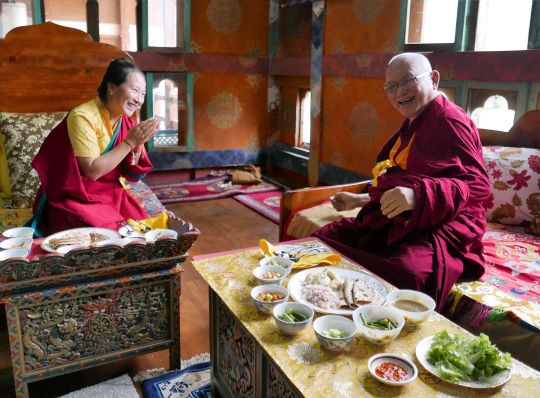
Lama Zopa Rinpoche enjoying lunch with Khandro-la in Bhutan, May 2016. Photo by Ven. Roger Kunsang.
“Discovering the suffering nature of samsara makes you very happy to restrain yourself from engaging in negative karma, in unrighteous actions,” declares Lama Zopa Rinpoche in his book Kadampa Teachings, adding, “The more you meditate, the more you discover that samsara and samsaric pleasures are only suffering in nature … Your wish to achieve liberation then becomes stronger.
“You then take vows, either lay vows such as the eight precepts or five lay vows or ordination as a monk or nun, with thirty-six or 253 vows. You are very happy to take vows, and you are also very happy to live in those vows. You don’t feel as if you living in a prison. The more analytical meditation you do, the more you discover the suffering nature of samsara and samsaric pleasures, especially the ones to which you are strongly attracted. The more you see that they are suffering, the more aversion to them you have and the stronger your wish to be free from them and achieve liberation. The very basic means to achieve liberation, to be free from this suffering, is by living in vows, either lay vows or the vows of a monk or nun. You are then very happy to do this, because you know that this is the path that protects you. This is your fundamental protection, protecting you from delusions, from negative karma and from all the sufferings of samsara. The stronger your thought to achieve liberation, the happier your mind is when you’re living in vows. It’s not that anybody is forcing you; it comes from your own heart. It’s as if you are suddenly being released after being in prison for a long time.”
Read more from Kadampa Teachings on the Lama Yeshe Wisdom Archive:
https://www.lamayeshe.com/article/chapter/kadampa-teachings
Get the e-book or a print copy from the Foundation Store and support FPMT International Office:
https://shop.fpmt.org/Kadampa-Teachings–Hard-Copy_p_1283.html
Lama Zopa Rinpoche is the spiritual director of the Foundation for the Preservation of Mahayana Tradition (FPMT), a Tibetan Buddhist organization dedicated to the transmission of the Mahayana Buddhist tradition and values worldwide through teaching, meditation and community service.
- Tagged: kadampa teachings, lama zopa rinpoche
- 0
26
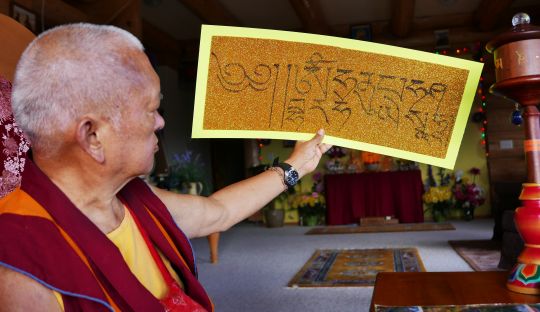
Lama Zopa Rinpoche examines the “Just by Seeing” mantra he has written out, Washington, USA, October 2016.
“Merely seeing this mantra purifies 100,000 eons of negative karma,” says Lama Zopa Rinpoche, adding, “This is said by Buddha in the sutra Pagpa Chu Lung Rolpai Do.”
Called the Pagpa Chu Lung Rolpai Do mantra or the “Just by Seeing” mantra, one is purified by merely seeing it in Tibetan says Lama Zopa Rinpoche, who in the above photo is holding up a copy he has recently written out himself while on retreat in Washington State.
The “Just by Seeing” mantra is spoken OM HANU PHASHA BHARA HE YE SVAHA and is reproduced again here in easier-to-read Tibetan:
Mantras, meaning “mind protection,” are Sanskrit syllables that are usually recited in conjunction with the practice of a particular meditational deity and embody the qualities of the deity with whom they are associated. They bring benefit to all who see, touch, hear, or speak them. Some mantras are so powerful that they are said to be able to benefit others even when no virtuous motivation is present.
The Just by Seeing / Pagpa Chu Lung Rolpai Do mantra is available on the FPMT.org mantras page.
This mantra is also found on the Precious Mantra Hat designed by Lama Zopa Rinpoche and available through the Foundation Store.
For advice from Lama Zopa Rinpoche about the benefits of particular mantras, or how to engage with mantras to eliminate or reduce obstacles, please visit FPMT.org for Advice from Lama Zopa Rinpoche and the Lama Yeshe Wisdom Archive for Lama Zopa Rinpoche’s Online Advice Book.
- Tagged: lama zopa rinpoche, mantras
- 0
24
“We are completely hallucinating,” Lama Zopa Rinpoche says in his latest book, Sun of Devotion, Stream of Blessings, newly available from Lama Yeshe Wisdom Archive in print and digital formats.
He continues: “This is the real situation we are faced with. It is a big mistake—the biggest mistake—that we make, to see things as existing from their own side, existing by themselves, as truly existing. To use ordinary language, things appear real to us, real from there. This ignorance is a hallucination; it decorates an object. I find this a very interesting way of describing it. This is how it happens. Past ignorance has left an imprint on the mind and that negative imprint decorates, projects, the hallucination, making the I appear as real. Whatever the object of the mind is—the I, the action, the object, form, sound, smell, taste, tangible object—the whole thing appears to us as real. There is a real car, a real road, a real sky, a real shop, real ice cream, real money … In the real gompa there are real flowers, real thangkas, real statues. Everything is real … We have no idea that it is only a hallucination …
“Everything is totally empty. It’s like a dream, like an illusion. If we are able to meditate this way, looking at all this like a dream, an illusion, a mirage—all the different examples—then it becomes very interesting. There is nothing to become attached to because it is not real.”
Read more from Sun of Devotion, Stream of Blessings on the Lama Yeshe Wisdom Archive:
https://www.lamayeshe.com/article/chapter/sun-devotion-stream-blessings
Get the book from the Foundation Store and support FPMT International Office:
https://shop.fpmt.org/Sun-of-Devotion-Stream-of-Blessings_p_2690.html
Lama Zopa Rinpoche is the spiritual director of the Foundation for the Preservation of Mahayana Tradition (FPMT), a Tibetan Buddhist organization dedicated to the transmission of the Mahayana Buddhist tradition and values worldwide through teaching, meditation and community service.
19
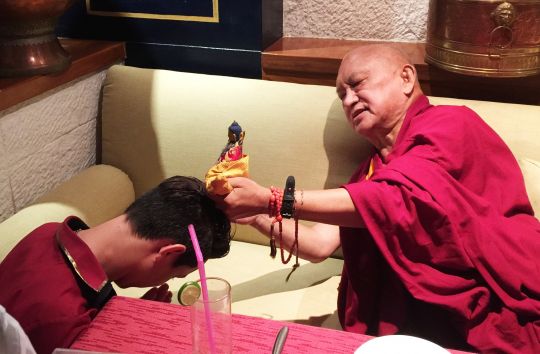
Lama Zopa Rinpoche blesses a waiter in a restaurant in Thailand, June 2016. Photo by Ven. Holly Ansett.
“Every single sentient being … is our wish-granting jewel,” Lama Zopa Rinpoche instructs in his latest book, Sun of Devotion, Stream of Blessings, newly available from Lama Yeshe Wisdom Archive in print and digital formats. He adds, “This is the purpose of our life, to live for them, for their happiness, to serve them.”
“Maybe you are working in an old folks’ home or something and you take care of one old person,” Rinpoche continues. “You should think … that you are so fortunate to be able to use your body, speech, and mind, your limbs, to serve this one sentient being. Remembering that all your past lives’ happiness, your present happiness and your future happiness all come from this person, you should see him or her as most kind, most precious, most dear. Then you serve that person in whatever way you can. If there is something you are unable to do, what to do? We are all limited in power, but whatever you are able to do, offer that service from your heart … offer your body, speech, and mind. That is the best Dharma, the best meditation. Then you will be happy. The more you appreciate how precious serving another being is, the more you enjoy it. It doesn’t have to be a guru you are serving. Your mind will be so happy to serve, whatever you can do. This applies to even the small things in your daily life: offering your seat to somebody on the bus, helping somebody carry a heavy load or, as my guru Kyabje Tsenshap Serkong Rinpoche often mentioned, rescuing a drowning insect. Try to do whatever you can to help, according to your capacity, whether it’s big or small.”
Read more from Sun of Devotion, Stream of Blessings on the Lama Yeshe Wisdom Archive:
https://www.lamayeshe.com/article/chapter/sun-devotion-stream-blessings
Get the book from the Foundation Store and support FPMT International Office:
https://shop.fpmt.org/Sun-of-Devotion-Stream-of-Blessings_p_2690.html
Lama Zopa Rinpoche is the spiritual director of the Foundation for the Preservation of Mahayana Tradition (FPMT), a Tibetan Buddhist organization dedicated to the transmission of the Mahayana Buddhist tradition and values worldwide through teaching, meditation and community service.
17
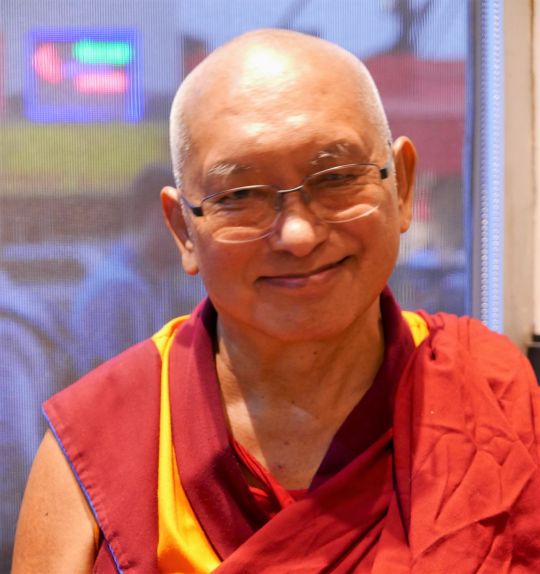
Lama Zopa Rinpoche visiting New York City, US, August 2016
A student served as secretary to an FPMT center for many years. Lama Zopa Rinpoche sent his thanks:
My very dear student,
Billions, zillion, trillion times numberless thanks to you for working with your body, speech, and mind in the center for fifteen years.
The purpose of the center’s existence is for the teachings of Buddha. And the teachings of Buddha are for the happiness of sentient beings—to free them from oceans of samsaric suffering, from the six realms, to bring them to peerless happiness, the complete cessation of obscurations and complete realization. You should recognize your service is like limitless skies of benefit. What you are working for are the teachings of Buddha—the Lesser Vehicle teachings, the Greater Vehicle teachings, sutra and tantra, the path of the Buddhadharma—that benefit sentient beings: numberless hell beings, hungry ghosts and animals; numberless sentient beings in the ocean and in the mountains; some we can’t see with our eyes; some we have to see through a machine; some that live in the ground; tiny insects walking in the grass, running everywhere in the grass; beings in the bushes and in the sky. You are benefiting every mosquito, every ant, every tick, every maggot, and so forth; numberless human beings; numberless suras, asuras, and intermediate state beings. And there are numberless universes, not only this one. You are benefiting all those different sentient beings.
In the morning when you come to work, think this: “I am going to work for all sentient beings, to free them from oceans of samsaric suffering and to bring them to peerless happiness.” That’s the motivation for all day long for body, speech, and mind—it doesn’t matter what you do. Of course, because you have received teaching from little me, Mickey Mouse, we have the connection of Dharma and the relationship of guru and disciple.
It is said in the root Kalachakra tantra that even if in all past, present, and future eons, at all times, you make offerings to Buddha, Dharma, and Sangha, even saving ten million creatures’ lives from being killed, you won’t achieve enlightenment in this life. But, by pleasing with devotion a guru who has an ocean of knowledge, then you can achieve common and sublime realizations, including enlightenment, in this life. That’s what you are doing!
Another quotation from the tantra of Yeshe Gyatso (“Ocean of Tantra Wisdom”) says that the person who is wise in activities and service to the guru, that fortunate being has a more meaningful life than having done prostration to the ten directions’ buddhas (that means numberless buddhas), for 10 million eons and 600 thousand eons. If one fulfills all the advice given by the guru, then all one’s wishes get fulfilled, and one achieves unfathomable limitless merit and good luck.
Sakya Pandita, one of the five great Sakya lamas, from where the Sakya lineage comes, said that even the merit collected from thousands of eons of making charity to others with your head, legs, and hands, even the merit collected from that, is not as much as the merit collected in one second on the path of the guru, which means fulfilling the guru’s wishes, following the guru’s instructions, and giving service to the guru. Each second you do that you are able to collect extensive merit. What you would have collected over thousands of eons, here, you collect in one second. That means every year, every month, week, day, hour, minute, and second that you are doing things for me, following my wishes and advice, you are not only collecting that much merit and good luck, you free yourself quickly from oceans of samsaric suffering. Every second you become closer to enlightenment, to buddhahood. This is such a quick way to achieve enlightenment. You should remember this every day with the work of your body, speech, and mind. Therefore, every day and every night, you should enjoy your life and how you’re making your life most great. Remember this especially when you are going to die.
The extremely learned actualized holy being Mig Pemba said that if one thinks the Buddha is in front of oneself, the Buddha abides in front of oneself, and the Buddha always blesses the mind of oneself and liberates it from all the mistakes—not only suffering and negative karma, but all the delusions and obscurations. That means for the disciple who thinks the guru is Buddha, then Buddha is always in front of that person, and the benefit that person receives is total cessation of all obscurations and total and complete realization.
Nagarjuna, like a second Buddha, spread the Buddha’s teachings. He abandoned all the offerings to Buddha, but attended perfectly and made offering perfectly to the guru. Service with one’s body, speech, and mind, fulfilling the wishes and advice of the guru, this is how to make the most of one’s life. I don’t know how many years, months, weeks, hours, minutes, seconds you have, but life is very short. And you are making the best use of it, not only for yourself, but for all sentient beings. So I’m truly expressing my heart to you.
Thank you very much again a billion, zillion times. I heard from Geshe-la how you worked so perfectly and successfully. You can enjoy this up to enlightenment and even after enlightenment. When you see an insect, you should think what benefit you are giving it.
With much love and prayers,
Lama Zopa
Transcribed by Ven. Thubten Osel, May 2016. Edited by Mandala for inclusion on FPMT.org.
Learn more about Lama Zopa Rinpoche, spiritual director of the Foundation for the Preservation of Mahayana Tradition (FPMT), and Rinpoche’s vision for a better world. Sign up to receive news and updates.
12
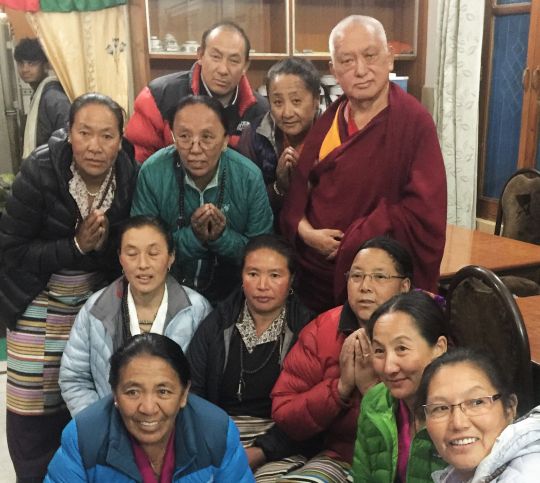
Lama Zopa Rinpoche visits with some Sherpa pilgrims, Tsopema, India, February 2016. Photo by Ven. Roger Kunsang.
“Cherish sentient beings first; put enlightenment second,” says Lama Zopa Rinpoche in his book The Joy of Compassion, available from Lama Yeshe Wisdom Archive online as well as in print and digital formats.
“Why do I say put enlightenment second?” he asks. “Of course, enlightenment is extremely important because without it you cannot work perfectly for sentient beings. You cannot be a perfect guide … But what should be the first thing in your heart, in your life, the goal of your life? Sentient beings. At present, who is the most precious person in your life, in your heart? It’s yourself or, if not yourself, then your greatest object of attachment. I don’t think you hold your object of anger most precious. It’s your object of attachment; that particular person. So that’s how you should hold sentient beings, feel them to be most precious. No matter how much you help the person to whom you are most attached, no matter how kind you are to that person, all you want is for that person to be happy. If that person receives help, achieves happiness, you’re satisfied. That’s your goal; you don’t want anything in return. You don’t need that person to respect you, to praise you or to do something good for you in return; you don’t have any such expectation. Your attitude is such that you are simply satisfied by that person’s receiving happiness or help. What do you call it—unconditional love? … Then, enlightenment is the method.”
Read more from The Joy of Compassion on the Lama Yeshe Wisdom Archive:
https://www.lamayeshe.com/article/joy-compassion
Get the book from the Foundation Store and support FPMT International Office:
https://shop.fpmt.org/The-Joy-of-Compassion-eBook_p_2364.html
Lama Zopa Rinpoche is the spiritual director of the Foundation for the Preservation of Mahayana Tradition (FPMT), a Tibetan Buddhist organization dedicated to the transmission of the Mahayana Buddhist tradition and values worldwide through teaching, meditation and community service.
- Tagged: compassion, lama zopa rinpoche, the joy of compassion
- 0
10
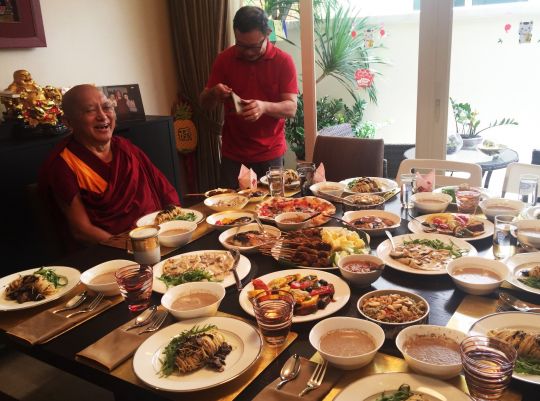
Lama Zopa Rinpoche prepares for a party in Singapore, February 2016
“You can collect a huge amount of merit even in your own home by having a party,” Lama Zopa Rinpoche instructs in his latest book, Sun of Devotion, Stream of Blessings, newly available from Lama Yeshe Wisdom Archive in print and digital formats.
“Whenever you throw a party for your family or friends,” he explains, “if you can also invite your enemy, that is the best party! That is something that worldly people don’t do. Worldly people usually harm the enemy, insulting him, shooting him and things like that. If you are a Dharma practitioner, you can invite your enemy and offer him apple pie or momos or whatever. At a party, if you think of each guest as your guru or His Holiness the Dalai Lama when you offer them food and drink, you are making offerings to your guru or His Holiness. In that way you collect the greatest merit and make the most powerful purification … So, by imagining all the guests at your party as your guru, as His Holiness, that is your Dharma practice, your guru devotion practice … It is such a quick way to achieve enlightenment.”
Read more from Sun of Devotion, Stream of Blessings on the Lama Yeshe Wisdom Archive:
https://www.lamayeshe.com/article/chapter/sun-devotion-stream-blessings
Get the book from the Foundation Store and support FPMT International Office:
https://shop.fpmt.org/Sun-of-Devotion-Stream-of-Blessings_p_2690.html
Lama Zopa Rinpoche is the spiritual director of the Foundation for the Preservation of Mahayana Tradition (FPMT), a Tibetan Buddhist organization dedicated to the transmission of the Mahayana Buddhist tradition and values worldwide through teaching, meditation and community service.
7
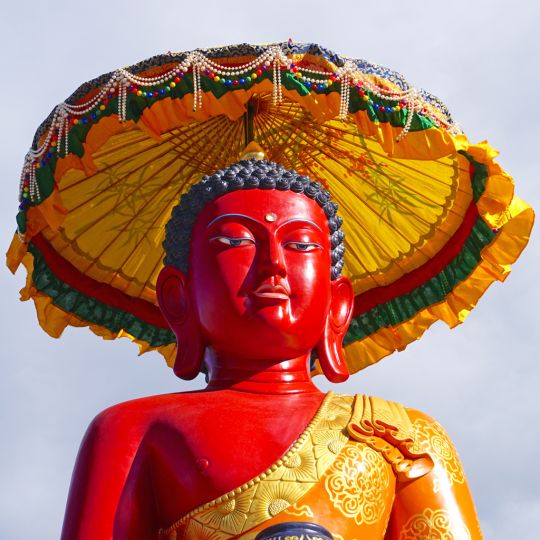
Amitabha Buddha during the celebration at Buddha Amitabha Pure Land, Washington, US, October 2016. Photos by Ven. Losang Sherab.
On Saturday, October 1, the second Amitabha Buddha Festival was held at Buddha Amitabha Pure Land in rural Washington State, US. About 60 people, which included neighbors, local students and guests from out-of-town, attended the celebration, which began at 9 a.m. and lasted until 5 p.m. The festival was envisioned by Lama Zopa Rinpoche to honor the large Amitabha Buddha statue and the retreat land that surrounds it and featured dance offerings and a community lunch. The 13-foot (4-meter) tall Amitabha Buddha statue is made of highest-quality white marble from Vietnam and weighs 16 tons (14,790 kilograms). It took over two years for the sculpting to be completed and was invited onto the land in late-June 2016.
About 25 Sherpas traveled from the Seattle and Portland areas to do one of the dance offerings in traditional dress and to help offer lunch, which was sponsored by Rinpoche. They were impressed by the land and the two large statues there and thought it beautiful. Students from nearby Pamtingpa Center in Tonasket, offered a Tara dance and a local Native American offered a song. (A dance offering by local Native Americans had been planned, but had to be canceled due to unforeseen circumstances.) The dances were performed facing the statue as well as the extensive offerings.
Rinpoche created the text for the celebration, basing it on Lama Tsongkhapa’s text for the Monlam celebration. The text includes an extensive bath offering, prayers to the 35 Buddhas of Confession, and an extensive offering practice, similar to one done during a long life puja. For each offering, Rinpoche held up the item being offered and recited the text in Tibetan. Ven. René Fuesi then read the meaning of the offering in English. This year Rinpoche composed two new verses about cars and airplanes that were added to the text:
Offering Trucks, Cars, Trains and Other Vehicles
Due to the merits of having offered these vehicles
May ourselves and all transmigratory beings
Realize the basis of the two truths.
(The truth for the absolute wisdom and the truth for the all obscuring mind)
And by completing the path method possessed by wisdom and wisdom possessed by method
Cross from beyond the oceans of samsaric suffering and
May the unified holy body and mind of Buddha be achieved.
Offering Airplanes
Due to the method of having offered these airplanes
And especially by the blessings of the Virtuous Friend,
The essence of embodiment of numberless Buddhas.
May ourselves and all transmigratory beings actualize the unification
Of holy body and holy mind of no more learning
In the brief lifetime of degenerated time.
When Rinpoche completes the celebration text, he has indicated that it can be used for other big festival days at FPMT centers around the world.
Resident Sangha and students from Pamtingpa Center took care of the arrangements for the celebration, which included collecting the offerings, building platforms, bringing chairs and carpets, putting up brocades, and sewing intricate umbrellas for the Amitabha Buddha and Medicine Buddha statues on the property and for the large Tara thangka that was also displayed during the festival.
The Sangha at Rinpoche’s house at Buddha Amitabha Pure Land were up all night finishing the preparations. The festival was scheduled at the last minute but came together beautifully and Rinpoche seemed pleased. He has said that he would like it to happen annually. The first Amitabha Buddha Festival took place in 2014. The festival didn’t happen last year due to devastating wildfires there.
Supporting the creation of holy objects is one of Lama Zopa Rinpoche’s vasts visions for FPMT.
More information, photos and updates about FPMT spiritual director Lama Zopa Rinpoche can be found on Rinpoche’s webpage. If you’d like to receive news of Lama Zopa Rinpoche via email, sign up to receive FPMT News.
- Tagged: amitabha buddha festival, buddha amitabha pure land, festival days, holy objects, lama zopa rinpoche, pamtingpa center, sherpas
- 0
5

Lama Zopa Rinpoche teaches to Western students, New York, US, July 2016. Photo by Ven. Lobsang Sherab.
“You have to start with words,” Lama Zopa Rinpoche teaches in his latest book, Sun of Devotion, Stream of Blessings, newly available from Lama Yeshe Wisdom Archive in print and digital formats, “but without actualizing the path in your mind, without transforming your life, then it is merely study.”
He adds, “Both sutra and tantra are what the monks studied in the monasteries in Tibet for their whole lives. Through that, numberless meditators became bodhisattvas and were able to achieve buddhahood, becoming enlightened beings. In many other holy places in Tibet practitioners also achieved realizations; not only Milarepa but many others attained enlightenment there as well. Because of that, there are many, many places in Tibet that are unbelievably blessed. Just as the pandits did in Tibet, you Western students also need to study what is written in the texts and, through intensive contemplation, meditate on and actualize the path. You must try to hold in your heart the teachings that the Buddha and those other great holy beings in India and Tibet explained. If you can do that then the West too can become an extremely blessed place, like India, Nepal and Tibet.”
Read more from Sun of Devotion, Stream of Blessings on the Lama Yeshe Wisdom Archive:
https://www.lamayeshe.com/article/chapter/sun-devotion-stream-blessings
Get the book from the Foundation Store and support FPMT International Office:
https://shop.fpmt.org/Sun-of-Devotion-Stream-of-Blessings_p_2690.html
Lama Zopa Rinpoche is the spiritual director of the Foundation for the Preservation of Mahayana Tradition (FPMT), a Tibetan Buddhist organization dedicated to the transmission of the Mahayana Buddhist tradition and values worldwide through teaching, meditation and community service.
4
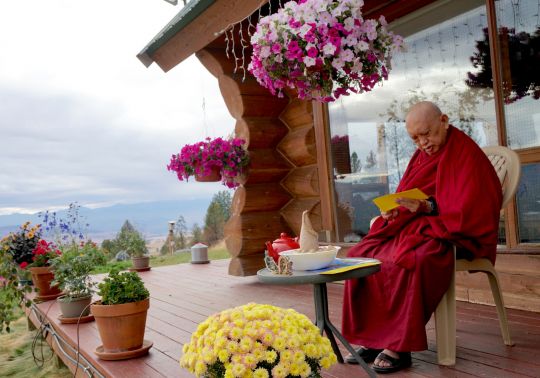
Lama Zopa Rinpoche praying at Buddha Amitabha Pure Land, Washington State, September 2016. Photo by Ven. Lobsang Sherab.
“In our life, whether we believe in karma, reincarnation, and so forth, we need to help others as much as possible.” So says Lama Zopa Rinpoche in his latest book, Sun of Devotion, Stream of Blessings, newly available from Lama Yeshe Wisdom Archive in print and digital formats.
He continues: “As my guru, Kyabje Tsenshap Serkong Rinpoche, says, we need to try to help even an insect that is suffering from having fallen into water by taking it out and freeing it. And if two insects are fighting, killing each other, we need to separate them. Even if we just offer to carry an older person’s heavy luggage or offer somebody a seat on the bus or train, even if it is just a small benefit in our everyday life, we should do whatever we can to help free others from suffering, to benefit them … To practice Dharma, the real thing is to serve others, to benefit others. Sentient beings are the objects most cherished by the buddhas … This tiny ant, this mosquito, this human—whether a rich man or a beggar—is the object most cherished by the numberless buddhas and bodhisattvas.”
Read more from Sun of Devotion, Stream of Blessings on the Lama Yeshe Wisdom Archive:
https://www.lamayeshe.com/article/chapter/sun-devotion-stream-blessings
Get the book from the Foundation Store and support FPMT International Office:
https://shop.fpmt.org/Sun-of-Devotion-Stream-of-Blessings_p_2690.html
Lama Zopa Rinpoche is the spiritual director of the Foundation for the Preservation of Mahayana Tradition (FPMT), a Tibetan Buddhist organization dedicated to the transmission of the Mahayana Buddhist tradition and values worldwide through teaching, meditation and community service.
3
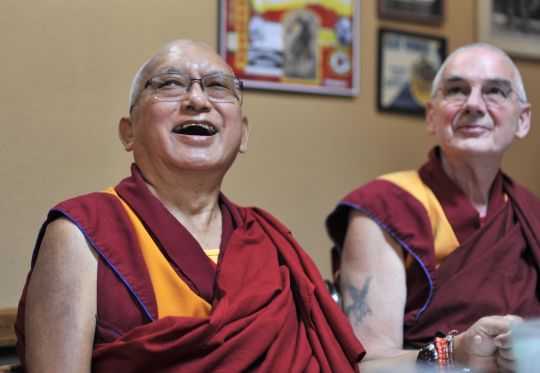
Lama Zopa Rinpoche with his attendant Ven. Roger Kunsang, Washington State, USA, September 2016. Photo by Ven. Lobsang Sherab.
“This is a real story,” recounts Lama Zopa Rinpoche in his latest book Sun of Devotion, Stream of Blessings, newly available from Lama Yeshe Wisdom Archive in print and digital formats.
“At Buxa, there was a monk called Jamyang, who was Pabongka Dechen Nyingpo’s attendant in Tibet. Even though he couldn’t read texts because he was illiterate—he couldn’t even read the Tibetan alphabet—Rinpoche had told him that in the future he would be able to read the Guru Puja by himself, without anybody teaching him. Then, one day in Buxa, he was suddenly able to read the entire Guru Puja from beginning to end. This was the blessing of having served Pabongka Dechen Nyingpo in Tibet. By serving him he purified his mind and it happened exactly as Pabongka Rinpoche had predicted. This was the great benefit of having impeccable guru devotion to Pabongka Rinpoche. He didn’t tell me this himself; Lama Lhundrup told me … There are many other stories of people serving the guru who have suddenly realized emptiness or seen deities. That is the power, the benefit of showing devotion to and serving our guru.”
Read more from Sun of Devotion, Stream of Blessings on the Lama Yeshe Wisdom Archive:
https://www.lamayeshe.com/article/chapter/sun-devotion-stream-blessings
Get the book from the Foundation Store and support FPMT International Office:
https://shop.fpmt.org/Sun-of-Devotion-Stream-of-Blessings_p_2690.html
Lama Zopa Rinpoche is the spiritual director of the Foundation for the Preservation of Mahayana Tradition (FPMT), a Tibetan Buddhist organization dedicated to the transmission of the Mahayana Buddhist tradition and values worldwide through teaching, meditation and community service.
28
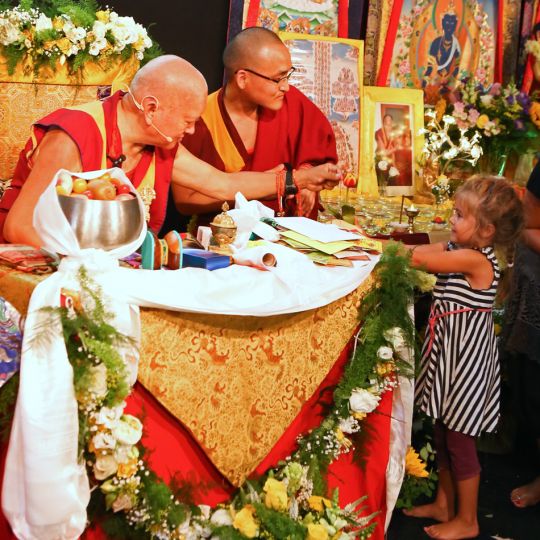
Lama Zopa Rinpoche during teaching at Maitreya Instituut, the Netherlands, July 2015. Photo by Ven. Thubten Kunsang.
Whenever Lama Zopa Rinpoche visits a holy site, a stupa or a gompa, he offers khatas to the statues and holy images there. During his visit to Maitreya Instituut Loenen in the Netherlands in July 2015, Rinpoche gave a spontaneous teaching on how to offer a khata to holy objects, which was captured in a short video. Rinpoche emphasized how you offer the khata on behalf of all sentient beings, how all spiritual attainments come from the guru and that you offer the khata so that oneself and all sentient beings may achieve the indestructible holy body.
Watch “How to Offer a Khata to Holy Objects” on YouTube:
https://youtu.be/kijVc2lWXHA
More information, photos and updates about FPMT spiritual director Lama Zopa Rinpoche can be found on Rinpoche’s webpage on FPMT.org. If you’d like to receive news of Lama Zopa Rinpoche and FPMT via email, sign up to FPMT News.
- Home
- News/Media
- Study & Practice
- About FPMT Education Services
- Latest News
- Programs
- New to Buddhism?
- Buddhist Mind Science: Activating Your Potential
- Heart Advice for Death and Dying
- Discovering Buddhism
- Living in the Path
- Exploring Buddhism
- FPMT Basic Program
- FPMT Masters Program
- FPMT In-Depth Meditation Training
- Maitripa College
- Lotsawa Rinchen Zangpo Translator Program
- Universal Education for Compassion & Wisdom
- Online Learning Center
- Prayers & Practice Materials
- Overview of Prayers & Practices
- Full Catalogue of Prayers & Practice Materials
- Explore Popular Topics
- Benefiting Animals
- Chenrezig Resources
- Death & Dying Resources
- Lama Chopa (Guru Puja)
- Lama Zopa Rinpoche: Compendium of Precious Instructions
- Lama Zopa Rinpoche: Life Practice Advice
- Lama Zopa Rinpoche Practice Series
- Lamrim Resources
- Mantras
- Prayer Book Updates
- Purification Practices
- Sutras
- Thought Transformation (Lojong)
- Audio Materials
- Dharma Dates – Tibetan Calendar
- Translation Services
- Publishing Services
- Teachings and Advice
- Find Teachings and Advice
- Lama Zopa Rinpoche Advice Page
- Lama Zopa Rinpoche: Compendium of Precious Instructions
- Lama Zopa Rinpoche Video Teachings
- ༧སྐྱབས་རྗེ་བཟོད་པ་རིན་པོ་ཆེ་མཆོག་ནས་སྩལ་བའི་བཀའ་སློབ་བརྙན་འཕྲིན།
- Podcasts
- Lama Yeshe Wisdom Archive
- Buddhism FAQ
- Dharma for Young People
- Resources on Holy Objects
- Ways to Offer Support
- Centers
- Teachers
- Projects
- Charitable Projects
- Make a Donation
- Applying for Grants
- News about Projects
- Other Projects within FPMT
- Support International Office
- Projects Photo Galleries
- Give Where Most Needed
- FPMT
- Shop
Translate*
*powered by Google TranslateTranslation of pages on fpmt.org is performed by Google Translate, a third party service which FPMT has no control over. The service provides automated computer translations that are only an approximation of the websites' original content. The translations should not be considered exact and only used as a rough guide.It is necessary to help others, not only in our prayers, but in our daily lives. If we find we cannot help others, the least we can do is to not harm them.







